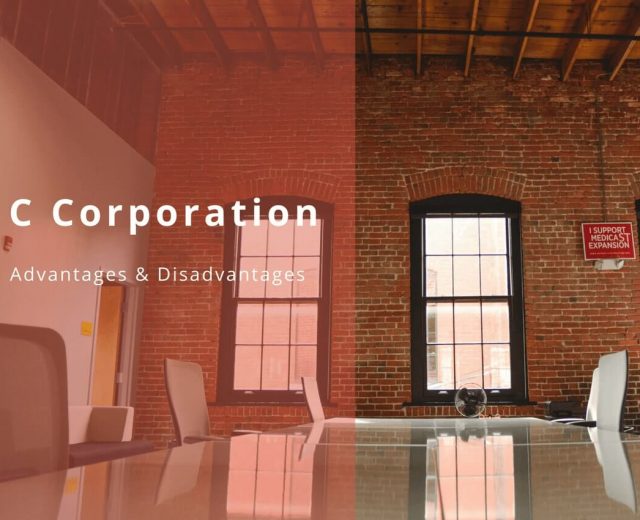For many years now, the complications of the tax code have prompted companies to ignore the traditional corporate form of business. In this case, it is the C corporation. And instead, build the ones that are known as “pass-throughs,” where they are taxed at the individual income tax rate and not at the corporate rate. The reason behind structuring a business as a pass-through one was so strong that in 2014, about 95% of America’s 26 million businesses were built that way.
The unfinished decrease in the corporate tax rate from a maximum of 35% to 20% would turn the equation for a lot of the taxpayers. This would also give some wage earners and business owners a method to protect their revenue and dodge paying taxes at a high tax rate. Since the individual tax rate is up to 42.3%. And all of this can be changed if only these people convert their business entities into C-corporations.

Since the Senate tax bill holds no rules that would limit the capability of experts like the doctors, lawyers, or managers to incorporate and have their work revenue perceived as corporate earnings, a business that is a non-corporate one might be elected to be eventually taxed at the corporate rate.
Along with this, the election can become simple, where it would just require the person to check a box on the form without the need of any elaborate paperwork or any lawyers. The tax screening would benefit the highest-income and the most financially mature Americans in methods that wouldn’t do anything to assist the overall country’s economy nor would it create any jobs. Other than this, it would also cost the Treasury a substantial amount of money.
While there are specific components of the proposals of the GOP that signify an enhancement to our contemporary system of corporate taxation, this event for shielding would introduce new incompetence prices to the domestic tax system, profit only the high-income taxpayers, and decrease the income.
There is only one way to put an end to the possibilities for tax arbitrage forever and to hold wealthier people in America from tricking the tax system for their benefit; it is to tax all the revenues for both the individual and businesses, at the same practical rates. But even though such an approach is absent in the system, the lawmakers should at least take care of the loopholes that would worsen this new form of tax securities.
Under the Senate Bill – High-income Taxpayer turn to C corp as tax shelters
Under the Senate bill, the highest rate on the wage earners would be 42.3% that includes both the payroll taxes and the income taxes. On the other hand, the highest rate on the revenue of the pass-through business owners would be 29.6%. This is while taking into account the advantage of the new deductions for the company owners who have a pass-through entity.
The shareholders of the C corp would pay 20% of the corporate tax, and along with this, they would also pay capital gains or dividend taxes on their personal tax returns with rates that are up to 23.8%. However, in this custom, the reasonable rate on the capital gains directs to be a lot less than the official rate. This is since the shareholders can delay in selling the shares and also since many provisions abolish the tax completely.
Along with the cheaper rate, the C-corp form would permit a lot of taxpayers the ability to subtract fringe benefits that a lot of the business owners of pass-through entities are currently unable to deduct. This includes fringe benefits and health insurance premiums. They would also be permitted to use the itemized deductions which include the local and state taxes that have been paid and it would no longer be deducted from the individuals.
This beneficial tax practice would provide some highly-paid pass-through business owners or salary earners massive incentives for turning their pass-through income and salaries into corporate profits. Furthermore, the capability of high-income taxpayers to change the form of their revenue from the higher-tax wages to the corporate profits is mostly unrestricted.
More About the New Tax Rate
Even though the Senate bill holds the requirements designed to restrict the capability of service companies such as those working in the fields of architecture, engineering, law, and health, for taking advantage of the new deductions for the businesses that are pass-through, there aren’t any prohibitions that have been applied to the C-corp businesses.
During the 1970s, when the highest individual income tax rates were remarkably greater than the corporate income tax rate, a lot of the individuals with a high-income incorporated their businesses as C corporations to shield revenue from the high personal tax rates. Now, converting from the pass-through structure to the C corporation structure is very simple.
Today’s business owners with pass-through companies would necessarily just click a box on the tax Form 8832, making a selection to be a C corporation. And this is the main reason why it is tough to debate that the proposal supports C corporations more than the pass-through companies, just like some of the Senators have suggested. The owners today can perpetually decide to file utilizing the system that reduces their taxes the most.
The significance of the tax division is expected to be substantial. In 2014, about 75% of the revenue of the pass-through that was a total of $ 674 billion increased to taxpayers bearing bracket rates above 25%. Meantime, 50% of the revenue of the pass-through that was a total of $ 464 billion raised to business people in the first two tax brackets. A significant share of those companies might profit by converting into C corporations so that they can pay a much cheaper tax rate.
C Corporation New Tax Rate Share on XAnother benefit: Wage-earning corporate managers
It is possible that a substantial share of salaries given to corporate managers would also change form, suppose, for one instance, people that own and manage firmly held C corporations or S corporations. Here, the firmly held corporations are those that have a very few shareholders, whose stock is usually not publicly traded. It is also the firm where the manager and the owner are normally the same people.
S corporations file a corporate tax return and are frequently subjected to the equivalent legal security just like the C corporations, but their revenue is passed-through proportionally to its shareholders.
And in the current times, these people usually choose to get the revenue of the corporation in the form of salaries since the highest tax rate on the salaries is much less as compared to combined rate on corporate profits. During 2013, the full earnings paid to the officers of the C corporations was only about $ 225 billion, and a preponderance of that settlement was given to the managers/owners of the small and firmly held C corporations.
Likewise, virtually all of the earnings given as S corporation officer commission were waged to people who were both employees and owners. All-in-all, these S corporation earnings reached about 57% of the total S corporation net business earnings. About 70% of that officer salary for S corporations increased for the people in the first 1% of the revenue division, who would have the most significant reason to change the structure of their pay. This is if the pass-through or corporate business rates decreased considerably pertinent to the rate on work earnings.
In situations like these where the manager and the owner are the same, the choice to switch from getting earnings as salaries to profits will be straightforward. But the workers with a higher income would be the ones who would also get in on the deal.
Without appropriate laws to restrict the capability for managers or workers to change their income into C corporation structure, we are expected to observe a significant improvement in the percentage of wealthy people that decide to do so. The only remaining reason why a person would not opt to do this is that the capital gains and the dividends would remain taxed at the individual level.
Nonetheless, numerous provisions exclude the tax at the second level, decreasing the rate to zero. These regulations would become immeasurably expensive or inclined to abuse vacant legislative reforms. There is only one way to actually remove the tax arbitrage and it is to place a tax rate on all the forms of income with the same tax rate.
Nevertheless, this system is unquestionably out of favor. And with this not possible to take place, we should concentrate on ending the loopholes that would permit a lot of the affluent people in America to dodge the larger tax rates that the lawmakers expect them to pay.
Fixing the loopholes
There are four ways to restrain C corporation tax sheltering:
So, what exactly are the loopholes that are there in the Senate bill and how is it possible to eliminate them? Eliminating or diminishing profits of numerous terms or prefacing anti-abuse laws would decrease possibilities for tax evasion. Policymakers should:
1. Demand taxpayers in every bracket to clear at least some taxes on the dividend and capital gains. Under the Senate bill, the rate of the tax on dividends and capital gains would prevail at zero for the taxpayers in the cheapest two tax brackets. This is applied to the couples that are married and have an income of up to $ 101,400. For instance, this would permit a taxpayer who has a higher-income to increase profits while operating in a company, giving just 20% tax, and then withdraws the income after their retirement tax-free.
2. Re-impose the carryover basis of assets transferred at death: The most significant loophole for business people of firmly held assets is the suspension from capital gains tax on assets that are retained until their death. At that moment, the assets that are passed forward to the successors have their support “stepped up” to the rate of the market at the death date. In conclusion, it basically means that none of the inheritors nor the descendant is accountable to pay any tax on the recognized price of the capital gain (those assets.)
In agreement with the higher estate tax inceptions, a procedure of borrowing against any appreciation and keeping the appreciated assets until death will be a profitable alternative to bypass capital gains tax as the people in question still have the complete access to the income. During 2010, when the estate tax was briefly abolished, the “carryover basis” was introduced and the “step up in basis” was also destroyed.
Under the “carryover” operation, any capital gain will sequentially become due when the successor trades the asset. And therefore rendering the very method that employs more frequently when the assets are sold. Re-imposing carryover authority or, better, gift for corporate shares or all assets, challenging achievements on death, would be appropriate and practical.
3. Build the anti-abuse laws for firmly held stock in Roth IRAs. The dividend and capital gains rate are zero for funds kept in Roth IRAs. Prevailing rules permit people to own firmly sustained with no publicly traded property in their Roths, causing such IRAs a vehicle for protecting workers wages. (It is not right for the Traditional IRAs since the regular tax rates affect when the revenue is distributed.) Building and strengthening the anti-abuse laws concerning non-public or jointly held shares would decrease tax avoidance.
4. Abolish the elimination of capital gains on Qualified Small Business Stock. Grants in qualified small business stock are eliminated from capital gains tax altogether up to a boundary of $ 10 million. Even though individual service companies might not qualify, a lot of companies currently in the form of pass-throughs might be eligible. Incorporating the company again into the C corporation structure would enable them to profit from this charitable opportunity. This tax investment has a limited argument on economic grounds, increases substantially to the taxpayers with the highest-income, and will prove to be expensive with a 20% corporate rate; it should be abolished.







